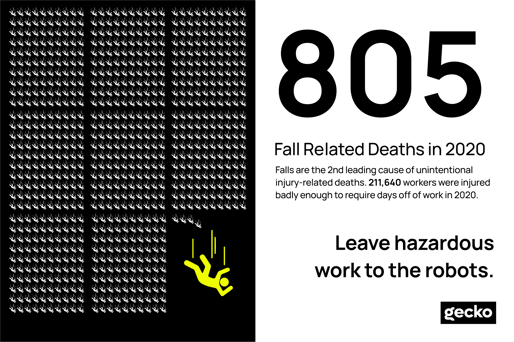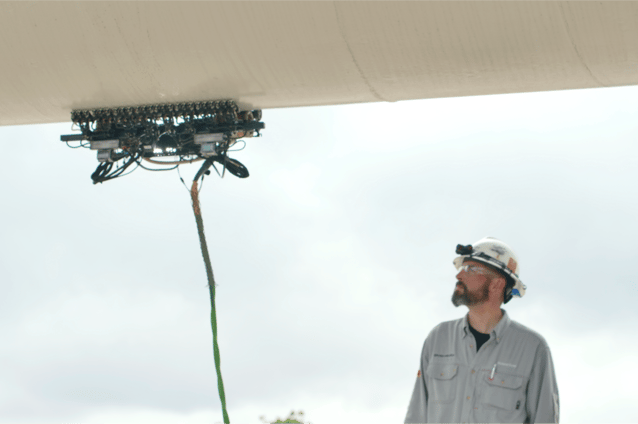You’ve seen the signs on the gates of refineries and other process industry facilities: “This plant has worked 147 days without a safety incident.”
For some plant managers, this sign is validation that good processes are in place. For others, especially plant safety engineers and managers (EHS), it’s counting the days leading to something bad inevitably happening.
The impacts of safety are twofold when it comes to asset management. First, traditional inspection methods are inherently dangerous to the facility workers and inspectors involved. There’s also a bigger picture that goes beyond the plant level. Without proper procedures, technology, and analysis, nearby communities and the environment are also at risk of disastrous events.
Here, we break down three ways that robotic inspections improve safety – at the plant level and beyond.
1. Streamline Complex Operations with a Smaller Human Footprint
Planned outages and turnarounds are important for reliability. However, they can often be quite complex. They require additional personnel working on several interdependent processes, putting inspectors and contractors in close contact with high-risk assets.
Add together the manual inspection teams, scaffolding or rope access crews, and supervisors, and you have a lot of boots on the ground in a relatively small section of your plant. Maintaining that flawless safety streak becomes more difficult when juggling all the people, processes, priorities, and schedules involved.
Alternatively, robotic inspection solutions reduce the number of people needed to conduct an inspection. For example, Gecko Robotics deploys teams that consist of two certified NDT inspectors and one robot compared to the 10-12 people needed for manual inspections. A smaller footprint reduces accidents and injuries by optimizing activity and involving fewer people in hazardous situations.
2. Reduce Human Exposure to Potential Safety Hazards
Working from heights further complicates manual inspections. Scaffolding-related issues were the fifth most cited OSHA violation in 2022, with fall protection as the main offender on the list. According to the National Safety Council, falls are the second leading cause of unintentional injury-related deaths. In 2020, 805 workers died in falls, and 211,640 were injured badly enough to require days off of work.

Minimizing work being done at elevated heights is one way to greatly improve safety. Any movement carries an inherent risk of mechanical failure for scaffolding, rope access, or lift machinery.
Robotic solutions, such as Rapid Ultrasonic Gridding (RUG), decrease the time spent working at heights and movement when elevated access is necessary. Gecko’s industry-leading technicians deploy robots safely from the ground level, leaving the hazardous heights for the robots to tackle. Robots can crawl the entire surface of assets without access requirements, reducing human exposure to safety risks while unlocking critical data insights.
There’s also the issue of confined spaces, which pose potentially hazardous conditions for inspectors. Robots can enter confined spaces that have not been cleared for human entry. Even when an inspector can safely get to equipment in confined spaces, they could run the risk of being exposed to hazardous atmospheres. Additionally, the physical contortions required to get into position to take a proper measurement can also result in injury.
For certain assets, a robotic inspection provides the option of performing an external, in-service inspection instead of emptying a vessel of its material and conducting an internal inspection. This mitigates the need for hazardous material handling and confined space entry. The robots can also operate on surfaces with dangerous temperatures, making it possible to capture data while maintaining safe distances from the asset.
3. Proactively Mitigate Risks with Deep Data Insights
The more you understand about an asset, the better you can maintain and protect it. Some facilities have Risk-Based Inspection (RBI) programs in place to help improve asset safety. However, not all inspection methods are equally accurate, efficient, or comprehensive.
Manual ultrasonic testing (UT) captures one reading per distance or grid, making it difficult to find localized corrosion or defects. Collecting data from select points may not accurately identify the full extent of damage mechanisms or may completely miss them altogether. Not only do these traditional methods lack data quality, but they are extremely time consuming to conduct.
Automated solutions like RUG utilize robots with 24 ultrasonic transducers to collect millions of A-scan data points at speeds up to 60 feet (18 meters) per minute. This equates to 1,000x more data in just a fraction of the time. 
Robotic solutions provide full-health analysis with complete coverage of an asset, removing guesswork and assumptions from the process. The unprecedented data captured by the robots gets fed into a data software platform to create useful dashboards and models with actionable insights.
Data visualizations can help estimate the remaining life of assets and pinpoint when and where targeted repairs are needed to improve the reliability and longevity of assets. By fully understanding asset health, you can strategically prioritize assets to ensure safe, seamless operations.
Using deep data insights unlocks the ability to go from a reactive approach to a predictive maintenance model, identifying and fixing problem areas before a failure occurs. Accurate, full-picture data empowers confident decisions that eliminate unplanned downtime and catastrophic failures.
Improve Workplace Safety and Efficiency Simultaneously
Safety should always be the top priority. We cannot downplay the importance of identifying pre-symptomatic damage issues, considering the consequences of equipment failure.
Inspection data captured by Gecko’s robots enables plant management to more accurately detect unexpected damage mechanisms such as corrosion, fatigue, creep, crack-like fractures, or HTHA. These conditions can and do lead to chemical releases, human exposure, fires, explosions, and environmental hazards.
Not only does Gecko’s data give a comprehensive picture of the current state of equipment integrity, but it can also be accessed at any time to compare against future inspections for the calculation of damage trends and rates. You can set an accurate, objective benchmark for current conditions and better predict and plan to mitigate risks in the future.
But there doesn’t need to be a tradeoff between safety and efficiency. By using the right technologies, workplaces can become safer while also improving productivity and reducing expenditures, resources, and inspection time frames. Using advanced robotics and data software helps facilities get the right information at the right time to maximize safety, reliability, and sustainability.
Download this case study to learn how Gecko Robotics helped an oil and gas leader ensure safety, avoid asset failures, and save millions of dollars in maintenance costs.
